In the ever-evolving world of compact vehicles, two strong contenders stand out for 2024: the BMW 1 Series and the Volkswagen T-Roc. Both models have loyal followings and unique selling points that appeal to different driver preferences. While the BMW 1 Series leans towards the hatchback segment with a sporty edge, the VW T-Roc captures the SUV audience with its robust styling and practical features. In this comparison, we delve into the technical aspects and innovations of both cars to help potential buyers make an informed decision.
BMW 1 Series vs VW T-Roc – Differences & prices compared
Two cars, one duel: BMW 1 Series meets VW T-Roc.
Which one wins in performance, efficiency and value for money? Find out now!
Exterior Design: A Battle of Styles
The BMW 1 Series showcases a classic hatchback silhouette, emphasizing its sporty character with bold lines and a muscular stance. The design is both modern and elegant, with the iconic kidney grille and sharp LED headlights, creating a dynamic presence on the road. Its compact dimensions (4361 mm in length) allow for agility while maintaining an appealing aesthetic.
Conversely, the VW T-Roc exudes a more rugged vibe typical of an SUV. With a slightly larger footprint at 4236 to 4271 mm in length, it offers a more commanding road presence. The distinctive grille and high-set headlights blend seamlessly with its cladding and body contours, giving it a youthful, adventurous look. The higher ground clearance adds practicality, making it ideal for diverse driving conditions.
Performance and Engine Options
When it comes to performance, the BMW 1 Series offers a range of engine types, including efficient diesel and petrol MHEV options. Power outputs span from 122 to a thrilling 300 HP, catering to both everyday commuters and performance enthusiasts. With impressive acceleration times, such as 4.9 seconds from 0 to 100 km/h in its most powerful variant, the 1 Series doesn’t shy away from delivering an exhilarating driving experience.
In contrast, the VW T-Roc presents a solid lineup with engines ranging from 115 to 300 HP, including both petrol and diesel options. While its most powerful engine can achieve a 0 to 100 km/h time of 4.9 seconds, its other configurations maintain a balance between power and efficiency, with fuel consumption as low as 4.7 L/100 km. This versatility makes the T-Roc appealing to a broader audience looking for both economy and performance.
Transmission and Drive Types
The BMW 1 Series incorporates advanced automatic transmission options, specifically a dual-clutch system that enhances driving dynamics. Available in both front-wheel and all-wheel drive configurations, it allows for excellent traction and stability, especially in performance models.
The VW T-Roc, on the other hand, provides flexibility with manual and automatic transmission choices, ensuring a broader appeal to various driving styles. Like the BMW, it also offers front-wheel and all-wheel drive variants to accommodate different terrains and driver preferences.
Interior Comfort and Technology
Inside the BMW 1 Series, drivers are welcomed by a driver-centric cockpit that blends luxury with technology. Premium materials and meticulous craftsmanship are evident throughout, while the latest infotainment system—supporting seamless connectivity and navigation—keeps you entertained and informed on the go.
The T-Roc's interior, while also modern, focuses on practicality and usability. Its layout is spacious, allowing passengers to enjoy comfortable seating. Technology features such as a digital dashboard and Apple CarPlay/Android Auto compatibility boost its appeal, making it a practical choice for families and everyday drivers alike.
Safety and Innovations
Both models are equipped with cutting-edge safety features. The BMW 1 Series comes with a host of standard features, including advanced driver assistance systems like lane departure warning and adaptive cruise control, reflecting BMW's commitment to safety and innovation.
The VW T-Roc mirrors this philosophy with its array of standard and optional safety technologies. Features such as pedestrian monitoring and adaptive lighting enhance safety, showcasing VW's focus on making driving as secure as possible.
Conclusion: Which One to Choose?
Ultimately, the choice between the BMW 1 Series and VW T-Roc boils down to personal preference and driving needs. If you seek a sporty hatchback that delivers high performance and luxury, the BMW 1 Series is undoubtedly an excellent choice. On the other hand, if practicality, SUV styling, and versatility are your primary concerns, the VW T-Roc will fit the bill perfectly. Both vehicles offer unique strengths, ensuring drivers can find a model that perfectly complements their lifestyle.
Here’s where it gets real: The technical differences in detail
Costs and Efficiency:
Price and efficiency are often the first things buyers look at. Here it becomes clear which model has the long-term edge – whether at the pump, the plug, or in purchase price.
VW T-Roc has a slight advantage in terms of price – it starts at 26400 £, while the BMW 1 Series costs 28800 £. That’s a price difference of around 2362 £.
Fuel consumption also shows a difference: BMW 1 Series manages with 4.30 L and is therefore noticeable more efficient than the VW T-Roc with 5.50 L. The difference is about 1.20 L per 100 km.
Engine and Performance:
Power, torque and acceleration say a lot about how a car feels on the road. This is where you see which model delivers more driving dynamics.
When it comes to engine power, the BMW 1 Series has a convincingly edge – offering 300 HP compared to 150 HP. That’s roughly 150 HP more horsepower.
In acceleration from 0 to 100 km/h, the BMW 1 Series is convincingly quicker – completing the sprint in 4.90 s, while the VW T-Roc takes 8.90 s. That’s about 4 s faster.
In terms of top speed, the BMW 1 Series performs somewhat better – reaching 250 km/h, while the VW T-Roc tops out at 212 km/h. The difference is around 38 km/h.
There’s also a difference in torque: BMW 1 Series pulls evident stronger with 400 Nm compared to 250 Nm. That’s about 150 Nm difference.
Space and Everyday Use:
Cabin size, boot volume and payload all play a role in everyday practicality. Here, comfort and flexibility make the difference.
Both vehicles offer seating for 5 people.
Both models weigh roughly the same – around 1465 kg.
In terms of boot space, the VW T-Roc offers slightly more room – 475 L compared to 380 L. That’s a difference of about 95 L.
In maximum load capacity, the VW T-Roc performs slightly better – up to 1350 L, which is about 150 L more than the BMW 1 Series.
When it comes to payload, VW T-Roc minimal takes the win – 515 kg compared to 510 kg. That’s a difference of about 5 kg.
Who wins the race?
The BMW 1 Series proves to be leaves the rival little chance and therefore becomes our DriveDuel Champion!
BMW 1 Series is the better all-rounder in this comparison.
 @ BMW Group Press
@ BMW Group Press
BMW 1 Series
BMW 1 Series
The BMW 1 Series is a compact premium hatchback that injects a proper sense of driving fun into everyday life, with sharp handling and a cabin that punches above its class. It’s a great pick for buyers who want sporty manners without losing practicality, and yes, you’ll still get that unmistakable BMW grin behind the wheel.
details @ BMW Group Press
@ BMW Group Press
 @ BMW Group Press
@ BMW Group Press
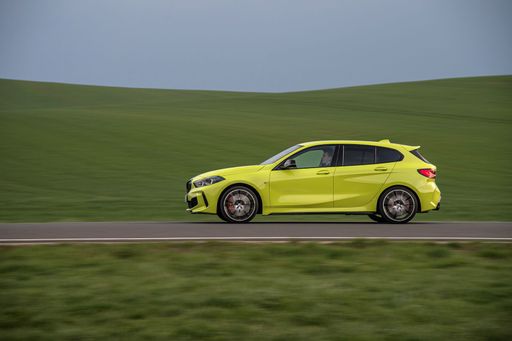 @ BMW Group Press
@ BMW Group Press
 @ BMW Group Press
@ BMW Group Press
 @ BMW Group Press
@ BMW Group Press
VW T-Roc
The VW T-Roc mixes cheeky, coupe-like styling with the everyday sense and space of an SUV, so it looks fun without sacrificing family sense. It’s a likeable all-rounder with tidy road manners and plenty of personality, ideal if you want a car that’s practical enough for chores but entertaining enough to enjoy.
details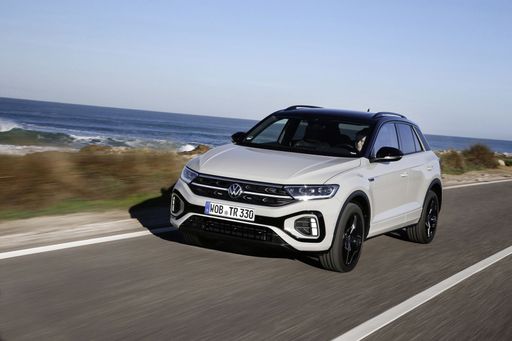 @ Volkswagen AG / VW Media
@ Volkswagen AG / VW Media
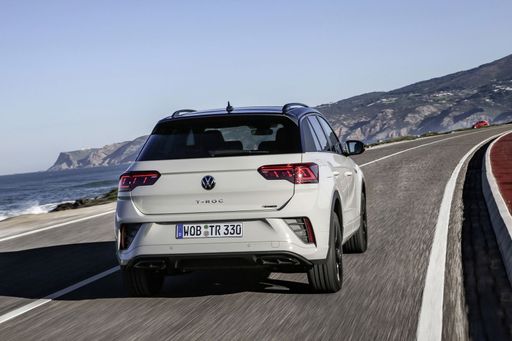 @ Volkswagen AG / VW Media
@ Volkswagen AG / VW Media
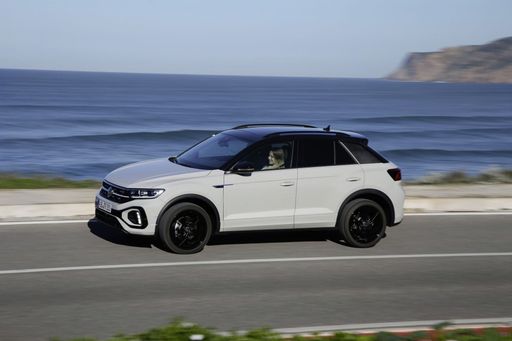 @ Volkswagen AG / VW Media
@ Volkswagen AG / VW Media
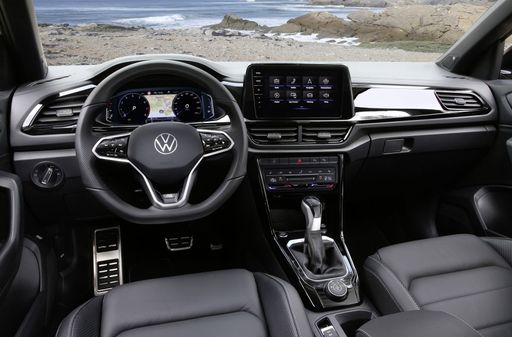 @ Volkswagen AG / VW Media
@ Volkswagen AG / VW Media
 @ BMW Group Press
@ BMW Group Press
|
 @ Volkswagen AG / VW Media
@ Volkswagen AG / VW Media
|
|
|
|
Costs and Consumption |
|
|---|---|
|
Price
28800 - 51100 £
|
Price
26400 - 38000 £
|
|
Consumption L/100km
4.3 - 7.6 L
|
Consumption L/100km
5.5 - 6.3 L
|
|
Consumption kWh/100km
-
|
Consumption kWh/100km
-
|
|
Electric Range
-
|
Electric Range
-
|
|
Battery Capacity
-
|
Battery Capacity
-
|
|
co2
112 - 173 g/km
|
co2
126 - 143 g/km
|
|
Fuel tank capacity
49 L
|
Fuel tank capacity
50 L
|
Dimensions and Body |
|
|---|---|
|
Body Type
Hatchback
|
Body Type
SUV
|
|
Seats
5
|
Seats
4 - 5
|
|
Doors
5
|
Doors
2 - 5
|
|
Curb weight
1465 - 1625 kg
|
Curb weight
1465 - 1539 kg
|
|
Trunk capacity
300 - 380 L
|
Trunk capacity
284 - 475 L
|
|
Length
4361 mm
|
Length
4271 - 4373 mm
|
|
Width
1800 mm
|
Width
1811 - 1828 mm
|
|
Height
1459 mm
|
Height
1527 - 1573 mm
|
|
Max trunk capacity
1135 - 1200 L
|
Max trunk capacity
1350 L
|
|
Payload
475 - 510 kg
|
Payload
368 - 515 kg
|
Engine and Performance |
|
|---|---|
|
Engine Type
Diesel, Petrol MHEV, Diesel MHEV, Petrol
|
Engine Type
Petrol, Petrol MHEV
|
|
Transmission
Automatic
|
Transmission
Manuel, Automatic
|
|
Transmission Detail
Dual-Clutch Automatic
|
Transmission Detail
Manual Gearbox, Dual-Clutch Automatic
|
|
Drive Type
Front-Wheel Drive, All-Wheel Drive
|
Drive Type
Front-Wheel Drive
|
|
Power HP
122 - 300 HP
|
Power HP
115 - 150 HP
|
|
Acceleration 0-100km/h
4.9 - 9.8 s
|
Acceleration 0-100km/h
8.9 - 12.3 s
|
|
Max Speed
210 - 250 km/h
|
Max Speed
187 - 212 km/h
|
|
Torque
230 - 400 Nm
|
Torque
200 - 250 Nm
|
|
Number of Cylinders
3 - 4
|
Number of Cylinders
3 - 4
|
|
Power kW
90 - 221 kW
|
Power kW
85 - 110 kW
|
|
Engine capacity
1499 - 1998 cm3
|
Engine capacity
999 - 1498 cm3
|
General |
|
|---|---|
|
Model Year
2024
|
Model Year
2024 - 2025
|
|
CO2 Efficiency Class
D, C, F
|
CO2 Efficiency Class
E, D
|
|
Brand
BMW
|
Brand
VW
|
What drive types are available for the BMW 1 Series?
The BMW 1 Series is offered with Front-Wheel Drive or All-Wheel Drive.
The prices and data displayed are estimates based on German list prices and may vary by country. This information is not legally binding.
